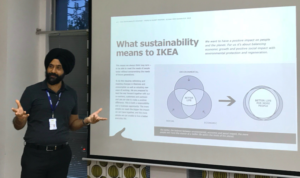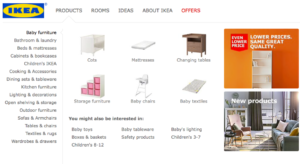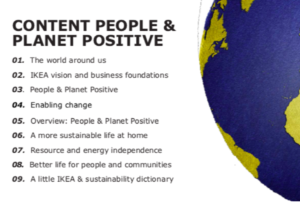By Christina Ameln, CSR | Sustainability Advisor –
Insights from Kanwarpreet Singh, Sustainability Compliance Manager, IKEA Purchasing & Logistics Southeast Asia.
Trust is imperative. Trust is what sets successful companies apart. Trust in sustainability lies not only in strategies, policies and procedures; it runs the full gamut from what a company says it will do to what it actually does in terms of compliance.
Swedish giant IKEA is a company that is trusted to do what it says it will do – and Kanwarpreet Singh, Sustainability Compliance Manager for IKEA Purchasing & Logistics South East Asia – preserves that trust for his region. Singh has a special quality that inspires calm and confidence. I am not exaggerating when I say that Singh has the persona and delivery of a zen master. The impression is nothing overwhelms him. Except, I learn from a reliable source, golf. Golf can apparently throw him off. We can all relate to that!
Okay, let’s admit that the word compliance is not overly exciting. But having trained as an SA8000 auditor and built a CSR compliance process for a Swedish company with a global remit, I know that compliance is essential to ensure that what is on paper is actually lived. Singh is what one could term the ‘enforcer’ of company values and the way business is done. He feels that his role has evolved in recent years. It is less ‘swords and daggers’ (my words) and more “an inclusive and communicative process” (his words).
 His initial experience, in his home country of India, was compliance and quality in manufacturing. His appreciation of the role of compliance was firmly set at this time as he oversaw the systems around production at a factory location. As a result, he has a unique understanding of what is realistic to expect from a factory without compromising other areas. His first foray into sustainability was in Cambodia where the learning curve was steep. Experience with a range of situations – from union conflicts to child labour – gave him deep insight on the importance of the conversion of these fields. He moved on to development of sustainability projects in Myanmar where, at the time, there were limited examples to guide his work on areas such as child labour, industrial relations, skill development, renewable energy and waste. He is now applying knowledge and experience of both compliance and sustainability to his work with the IKEA purchasing operations in Vietnam. He oversees the entire Southeast Asia region and views his work as more than filling out worksheets, “sustainability compliance is one of the inputs to ensuring responsible business and continued quality of products”.
His initial experience, in his home country of India, was compliance and quality in manufacturing. His appreciation of the role of compliance was firmly set at this time as he oversaw the systems around production at a factory location. As a result, he has a unique understanding of what is realistic to expect from a factory without compromising other areas. His first foray into sustainability was in Cambodia where the learning curve was steep. Experience with a range of situations – from union conflicts to child labour – gave him deep insight on the importance of the conversion of these fields. He moved on to development of sustainability projects in Myanmar where, at the time, there were limited examples to guide his work on areas such as child labour, industrial relations, skill development, renewable energy and waste. He is now applying knowledge and experience of both compliance and sustainability to his work with the IKEA purchasing operations in Vietnam. He oversees the entire Southeast Asia region and views his work as more than filling out worksheets, “sustainability compliance is one of the inputs to ensuring responsible business and continued quality of products”.
Walking the Talk
 Most families around the world have IKEA products in their homes. The IKEA offering is to sell well-designed and affordable products. What many families don’t know, however, is that IKEA is also selling them “affordable sustainability”. Singh proudly adds, “Our sustainability work is grounded in the IKEA People & Planet Positive strategy which includes: healthy and sustainable living; creating a positive social impact (fair and equal) across our entire value chain; and becoming climate positive and circular as its main focus”.
Most families around the world have IKEA products in their homes. The IKEA offering is to sell well-designed and affordable products. What many families don’t know, however, is that IKEA is also selling them “affordable sustainability”. Singh proudly adds, “Our sustainability work is grounded in the IKEA People & Planet Positive strategy which includes: healthy and sustainable living; creating a positive social impact (fair and equal) across our entire value chain; and becoming climate positive and circular as its main focus”.
In addition to doing solid groundwork through the development of strategies, processes and procedures, IKEA ‘walks the talk’ by having strong sustainability compliance in place. When I ask Singh why this is important, he responds: “it helps to ensure that we continue to do good business”.
 And when IKEA chooses its supply chain partners, it follows strict ground rules. Singh states: “The most important part of sustainability compliance is to ensure our business partners share our values of doing good business. This is detailed in the IKEA IWAY of working which defines IKEA’s minimum requirements relating to the environment and to social and work conditions. It is mandatory for our business partners to commit to IWAY before we enter into any business relationship”.
And when IKEA chooses its supply chain partners, it follows strict ground rules. Singh states: “The most important part of sustainability compliance is to ensure our business partners share our values of doing good business. This is detailed in the IKEA IWAY of working which defines IKEA’s minimum requirements relating to the environment and to social and work conditions. It is mandatory for our business partners to commit to IWAY before we enter into any business relationship”.
By having ‘eyes on the ground’ and supporting its supply chain partners, Singh says that IKEA reinforces sustainability compliance as it “also helps address emerging issues proactively in the supply chain”. Accordingly, sustainability compliance is both a reactive and proactive responsibility and goes beyond a checklist exercise. It links back to strengthening foundations and creating further opportunities for engagement and new ways of working.
A key example of furthering these opportunities is IKEA’s SOARÉ placemats, which are made in Vietnam. The product was reaching high volumes of up to 2 million sold per year. IKEA felt forced to shift from local weavers to machines to meet the demand. Before it took this decision, it visited the manufacturing areas and realised that this product was important to these communities – it was a good use of these fast-growing water hyacinth that clogged waterways and furthermore supplied an additional income to families contributing to a stronger community. If IKEA had not gone to ‘see’ for itself, it might not have understood the full impact on the weavers and how the production of these placemats was empowering communities. The solution for IKEA was to introduce both machine-made and hand-made placemats that both supported the increasing demand and the communities that produced it.
Beyond the Checklist
Indeed, compliance is often seen as ‘ticking the boxes’. But that is changing. With the general shift in sustainability from an add-on to the promotion of resilient sustainability strategies to an enabler for business in general, sustainability compliance is becoming better understood and appreciated. Singh sees the future of sustainability compliance as shifting from “policing” to helping supplying partners actively “own their compliance”. It’s a mind-set shift that takes time and explanation.
In the same way that we trust that IKEA is doing the right thing around sustainability, Singh explains that the trust has to move down the supply chain to IKEA’s supplying partners. “The first step is obviously working with business partners who want to work with us but who also share our values and sustainability objectives. And moving towards partners that want to do it verses those that have to do it. The shift will result in not having to check ‘all’ the boxes are ticked as they will own their compliance and have that high level of scrutiny themselves. Instead of us checking the same things over and over again, this will allow us to focus on other areas of the relationship and use our resources more efficiently.”
Undeniably this transition of responsibility along the supply chain is a relief for both companies and supplying partners. One of the biggest complaints that I hear about compliance is the number of audits and checks that need to take place, often checking the same thing several times over. This model puts responsibility on both the company and the supplying partner, allowing for stronger alignment and partnership. Compliance becomes given on which all partners agree.
Inspire and Motivate
 In a region as vast as Southeast Asia it is difficult to spur a collective effort. But Singh sees this as a positive since IKEA’s philosophy is to adapt to local needs. He explains: “Different regions require different approaches to sustainability work. Our focus areas in the People & Planet Positive strategy allow us room to prioritize some topics over others to best contribute to the needs in the countries we operate in”.
In a region as vast as Southeast Asia it is difficult to spur a collective effort. But Singh sees this as a positive since IKEA’s philosophy is to adapt to local needs. He explains: “Different regions require different approaches to sustainability work. Our focus areas in the People & Planet Positive strategy allow us room to prioritize some topics over others to best contribute to the needs in the countries we operate in”.
On the other hand, Singh would like to see more common development, clarification and enforcement around legal frameworks. The struggle of sustainability compliance is that interpretation and implementation of laws can vary from one region to another. IKEA’s set of rules might not be applicable locally, creating variance on best approaches. Commonality would have higher weight and get better results.
The divergence in approach applies not only with legal frameworks but also to other company brands. According to Singh, “Roadblocks do happen when different brands are using the same supplying partner as IKEA but have different approaches on sustainability compliance”.
These differences in approach mean that “It takes time and synergies to match for various stakeholders to act together”. Singh points out that his role is both about “demonstrating leadership; educating; inspiring; and motivating best business behaviour” and about “being an influencer to ensure positive impact”.
The Journey Continues
The journey is not over. This ‘zen master’ Singh continues to see other areas for improvement, including: youth engagement in the supply chain; working with migrant workers with the International Organisation on Migration (IOM); and home workers projects. He sees emerging issues in the region on water, waste circularity, renewable energy, industrial relations and aligning standards across countries.
As I ask Singh my final questions, he is clear that he has a “personal need to positively influence” and that he has been lucky that “my values and those of the companies that I have worked for have matched well”.
One of the values I see posted prominently on a wall as I walk out of the IKEA Purchasing office in Vietnam office is – Leadership by Example. And here I see that both the company and the individual embody how to be and how to work on responsible business.
For more information:
- About Kanwarpreet Singh, Sustainability Compliance Manager, IKEA Southeast Asia
- About IKEA
- IKEA Website
First published on November 14, 2018 on Linkedin.

